When it comes to swine dining, it’s as true as ever that you can’t fatten the pig on market day. Roasting pigs is a time-honored, and always well-attended past time that takes a good bit of preparation and know how to pull off.
Here at Cove Creek Farm, we’ve put in the time with our heritage breed, pasture and wood-lot raised pigs. And we’ve thrown a shindig or two that featured a roasted pig. Just like raising them, roasting whole hogs is a science, as well as an art born of experience.
In this guide we’ve worked through the steps to throwing the best pig roast you’ve ever seen, from choosing a hog to serve straight through to your guests’ bellies.
Steps to the Fine Art of a Good Pig Roast
- Picking the Right Pig for a Pig Roast
- The Best Equipment For a Pig Roast
- Prepping the Pig for a Pig Roast
- The Art of Roasting a Pig
- Tips From a Master Pig Roaster
Picking the Right Pig for a Pig Roast

A good pig roast can be the centerpiece of any party’s culinary offerings. With that said, proper preparation is a big deal (literally). Depending on the size of your event you’ll likely want to get at least a 40 pound pig. And as with any form of meat, quality sourcing is a must.
You can order whole hogs from a variety of locations. Most local butchers, wholesale meat packagers, or if you’re truly lucky a local farm can provide you with a particularly fresh pig. Large amounts of marbling in a pig is important for a succulent roast, and most often found in pasture-raised heritage pig breeds.
Besides the source, you’ll want to pick the right size pig for your gathering. The relationship between the weight of a pig and the eventual edible meat can be tricky to calculate.
- The Live Weight of a pig is the weight you’ll choose if you’re dealing with a pig that hasn’t been dressed (butchered and prepared). The live weight is substantially heavier than the eventual weight of edible meat.
- The Dressed Weight is the weight of the pig after it has been butchered and prepped for culinary purposes. A number of organs and other body parts are removed in the dressing of the pig (in some states, the head is required to be removed by law). Dressed weights are about 70% of the animal’s live weight.
- The Edible Meat Weight is often between 40-50% of the dressed weight of a pig. Elements that contribute to how much edible meat you get out of a dressed pig include the amount of shrinkage of meat during cooking, what percentage of the pig’s weight is bones (inedible) or parts that burn off during cooking. Bones are typically a larger percentage of the total weight of small pigs. This means the smaller the pig you choose, the greater percentage of weight loss between dressed weight and edible meat weight.
So what does this all mean? Well, it depends on your cooking style and how hungry the guests are.
A hearty pulled pork sandwich may have half a pound of meat on it. If you expect your guests at most to eat two sandwiches, and want to be prepared, you’ll want 1 pound of edible meat per guest.
Because of shrinkage during cooking and from loss of bones, you’ll want a dressed pig that weighs around two pounds per guest. If you’re going to be dealing with a larger pig, there will be slightly less weight loss by percentage due to bones being less of the roast. This means you can below two pounds per guest with larger dressed pigs, and potentially go a little over 2 pounds of dressed pig per guest for smaller pigs.
With dressed weight coming in at 70% of live weight, you’ll need to up your pound requirements even more. Depending on whether you’re buying a live weight or dressed pig, the following weights provide a rough guide to providing around one pound of cooked meat per guest. Adjust up or down to suit your particular needs. Pig Sizing: One Pound of Cooked Meat Per Guest
- Pig Live Weight for 20 Guests: 60 pounds
- Pig Dressed Weight for 20 Guests: 40 pounds
- Pig Live Weight For 50 Guests: 140 pounds
- Pig Dressed Weight for 50 Guests: 100 pounds
- Pig Live Weight for 75 Guests:210 pounds
- Pig Dressed Weight for 75 Guests: 150 pounds
Pig Sizing: .75 Pound of Cooked Meat Per Guest
- Pig Live Weight for 20 Guests: 45 pounds
- Pig Dressed Weight for 20 Guests: 30 pounds
- Pig Live Weight For 50 Guests: 105 pounds
- Pig Dressed Weight for 50 Guests:70 pounds
- Pig Live Weight for 75 Guests: 160 pounds
- Pig Dressed Weight for 75 Guests: 110 pounds
The Best Equipment For a Pig Roast
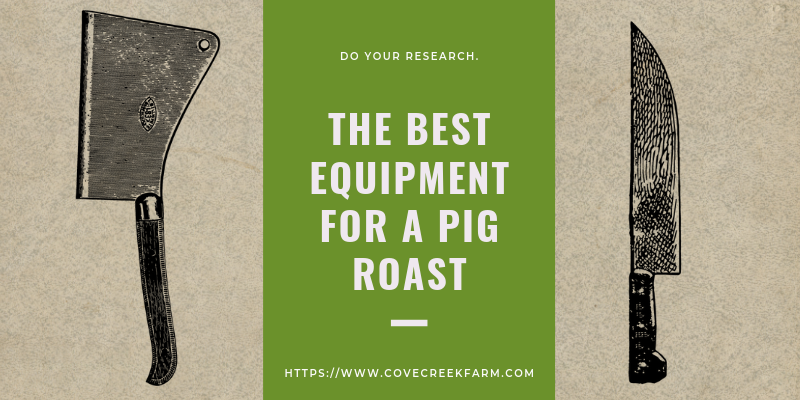
There are several popular routes to roasting a pig. At Cove Creek Farm, we use a special roaster we call the hot box. Hot boxes decrease the time it takes to finish roasting a succulent pig, as well as make it easier to retain hog skin and crisp it up.
Hot boxes can be bought, constructed, or rented. Our pig roast service can provide you with a rental hot box or we’ll even take care of the roast for you.
Hot boxes are essentially metal lined wooden boxes that hold a butterfly-ed pig. The tops of these radiant-heat roasting ovens are piled high with charcoal. Hot boxes can roast a pig in as little as 3.5 hours, depending on the size. And can be one of the tidiest ways to roast a pig with predictable results.
Besides the box itself, you’ll need the following equipment to hot box roast a pig the Cove Creek Farm way:
- Eight Large Bags of Kingsford Original Charcoal
- A Charcoal Chimney Starter
- A Grill Lighter
- A Pair of Insulated Gloves (or two if you need help moving the pig)
- And A Carving Knife
Roasting Spits are one of the oldest ways to roast a pig. While spits won’t roast a pig as quickly as a hot box, one major benefit is the ability to rotate the hog to distribute heat evenly. Additionally, spits can be used to roast two hogs side by side.
Typically, the best pigs to roast on a spit are those that are under 90 pounds. Younger pigs are often lower fat, and the application of a slow roasting spit pulls pork juices out for a tender result. Older and larger pigs tend to have more concentrations of fat. As the fat burns out, spits can lead to drier meat in larger hogs.
Besides the spit itself, the equipment you need for roasting a pig on a spit is similar to that of a hot box (above):
- One pound of charcoal per pound of the pig, with some left over
- A Charcoal Chimney Starter
- A Grill Lighter
- Tongs for Arranging Coals
- And a Carving Knife
Pit roasting requires a great deal more time than the hot box method. While dependent on the heat at which you roast the pig, a common cooking rate is that of 1 hour for every 10 pounds of the pig.
Finally, pit roasting of pigs is perhaps the oldest and most prep-intensive method of cooking a pig. Recognizable from Polynesian cuisine (and more popularly “Luau”-s), pit roasting is essentially building a “hot box” in the earth.
For this method you’ll need tools for digging, whether machinery or shovels. You’ll need to make a pit one foot larger than your pig in every direction, and three feet deep. And then line the pit with bricks or stones.
When you’re ready to cook your pig, fill the bottom of the pit with one foot of charcoal evenly spread. Once your pig is properly marinated and seasoned, wrap it in a burlap sack and place it into the pit. For larger pigs, many recommend placing heated rocks inside of the body cavity. Cover the pig with soil or metal. By depriving the contents of the pit of oxygen, you won’t have a fire anymore, but your coal and the surrounding pit will stay hot for several days.
Pit roasting is the most time-intensive way to roast a pig, particularly if you burn down a fire to gain your initial coals. Once the pig is in the pit, it can be roasted from 12 hours to two days depending on size.
Prepping the Pig For a Pig Roast
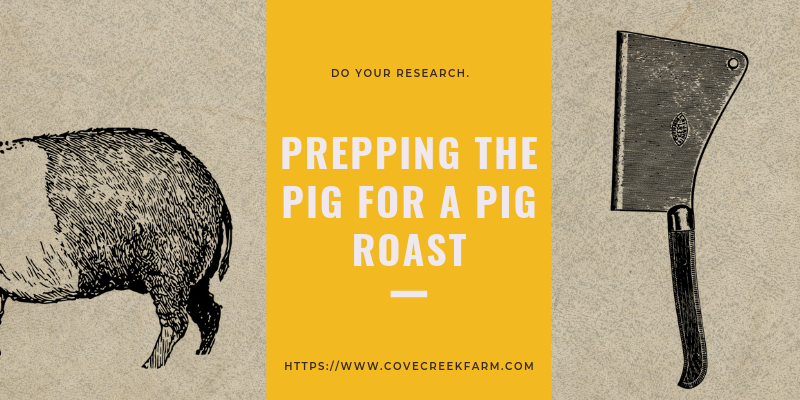
Relying on quality pork and a good roasting set up will only get you so far in making an epic roasted pig.
Preparation begins early, with many locations requiring about a week notice to dress your pig for you. Whether you’re buying from a butcher, or a farm that’s sending your pig to processing, build in some time so that you can get a pig worthy of the time it takes to cook.
After you’ve selected a pig by weight, breed, and method of raising, you’ll need to tell your butcher or processor how you would like your pig prepared. Here at Cove Creek Farm we request for the pig to be butterflied so that its legs will lay flat to the sides during the roast. Get the offal removed and depending on the regulations of your state have head and skin removed as well.
If your pig has been frozen at any point, make sure it is thawed and kept on ice as you approach your roast date. Under no circumstances should you try to roast a frozen pig. Once you’re two days out from the roast, place the pig in a large cooler filled with brine and ice. Replace ice and shake every few hours throughout the day. After two days of marinating, you’re ready to go!
The Art of Roasting a Pig
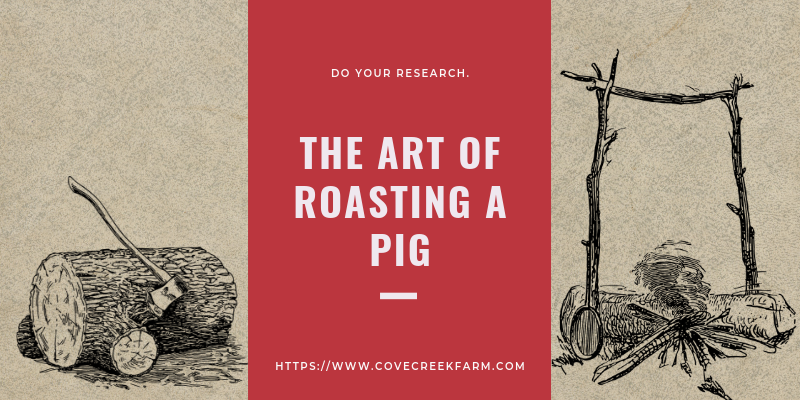
Roasting a pig is a large time commitment. It can also be a ton of fun. If done correctly, hours of anticipation, and hanging out with friends or family leads to a mountain of succulent pork meat.
Here at Cove Creek Farm, we utilize the hot box method of roasting a pig. We’re happy to rent out our hotbox, or even come by your event to oversee the cooking. If you’ve read this far, however, you’re probably sussing out whether you’re ready to tackle a pig roast on your own.
Unlike other methods of cooking, you won’t need to heat up the hot box before placing the pig into it. If you have all of the equipment detailed above, as well as a properly prepared pig, just follow the following steps for your first pig roast:
- Place the pig with legs flat out to the side on a roasting rake and lower rake into hot box.
- Cover hot box with lid.
- Use a charcoal chimney starter to light two mounds of charcoal at either end of the top of the hot box.
- Spread lit coals evenly across the top of the hot box.
- Roast the pig for 2.5-3 hours, depending on the size of the pig.
- Remove ash from top of lid, save hot coals in a metal trash can, remove lid.
- Flip pig over on roasting rake and reinsert roasting rake into the hot box.
- Re-cover the lid with coals, adding new coals to get to approximately the amount of coals started with.
- Light new coals.
- Roast for 2.5-3 more hours
- Remove lid.
- Remove pig and place on a cutting board
- Carve the pig and enjoy!
Tips from a Master Pig Roaster
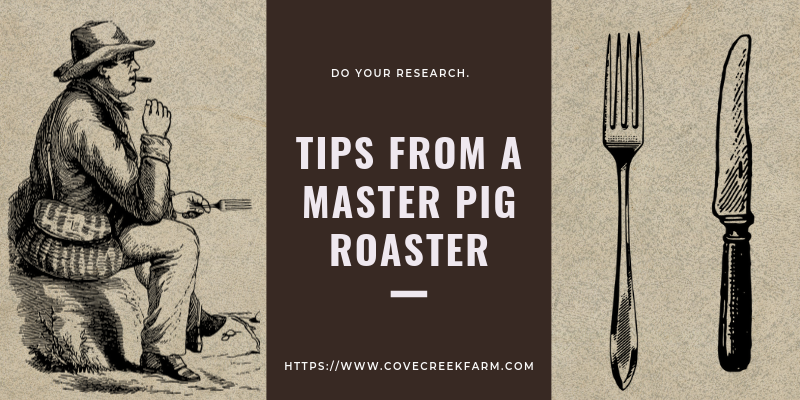
We’ve helped pull off more than a fair share of pig roasts in our time at Cove Creek Farm, from small gatherings to large parties. While everyone has their own “style” we’ve collected a series of tips to help you get started on your pig roasting journey. Question: Some preparation methods recommend basting the pig, is that necessary?
Answer: You can baste your pig, though in our experience it’s not necessary. If you prepare you pig correctly and slowly roast it at the proper temperature the pig will roast in its own juices creating a succulent, meat-falling-off-the-bone result.
Basting also isn’t possible with every method of pig roasting. With a spit, the pig is exposed while cooking, and thus the cook can baste as the pig is rotated. With hot box and pit roasting, pigs the pig is inside of the heated cooking apparatus for a vast majority of cooking time.
Question: What’s the best way to stuff a pig for roasting?
Answer: Stuffing a roasted pig is popular in some polynesian-style pig roasts. You by no means have to stuff your roasted pig. And there are cases in which stuffing a pig can lead to worse outcomes. Our recommendation is — if you’re going to stuff your roasting pig — to do so only in smaller pigs. The amount of time it takes to roast larger pigs can lead to “soggy” stuffings.
In the event of pit roasting — generally the slowest method of roasting pigs — starting the roast by placing heated rocks inside of the body cavity of the pig can help to speed the process up. Though these obviously aren’t edible “stuffings.”
Question: Do you have any tips for presentation?
Answer: Looks play an important part in taste, and the overall appeal in a meal. If you’ve done a pig roast before and found parts of your pig looking too charred, don’t be afraid to place aluminum foil around the most crisp-able elements like the ears, snout, and tail. At the end of your roast, if the pig is looking too dark throw some cooking or olive oil on the pig. This will moist and more “browned” appearance.
Question: What temperatures are important when roasting a pig?
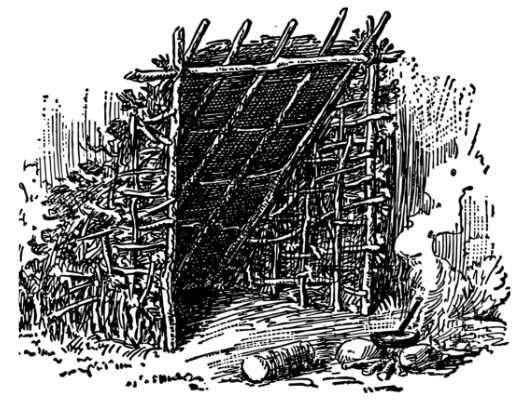
While you can get away with cooking smaller cuts of pork to lower temperatures, roasting is slow work that retains the juices of the hog. There’s also plenty of variation in density and heat retention abilities throughout a pig. So don’t be afraid to cook to an internal temperate of 180 degrees at spots throughout your pig. Properly roasted pig won’t dry up or taste overcooked even though this is a bit higher of a temperature than you may cook other cuts at.
With that said, if you’re ready to be a bit more vigilant towards the end of your roast, and you’re using a spit to control the distribution of heat through the pig’s body, you can aim to target different temperatures in different body parts. Many pig roasting pros aim for 145 degree or above in the bacon and lower belly region of the pig, and 160 degrees or above in the shoulder and haunches.
As far as your pit, spit, or hot box temperature, this depends on how long you’re going to roast your pig as well as the method you employ.
At Cove Creek Farm we recommend utilizing our hot box method. With this method, you don’t have to worry about monitoring the temperature. Just ensure the top of the hot box is covered with hot coals and cook for the recommended time based on the size of the pig.
For spit methods, you have control over both the temperature of the spit and the distance your pig is away from the spit. This means there are more variables to consider as you’re roasting your pig. But if you know what you’re doing you can tailor your set up to meet your needs. Most spit roasters recommend ensuring the surface of the pig is no closer than 12 inches to avoid body parts like the tail, ears, and skin from getting overly charred. As for temperatures, many recommend not raising the temperature of the pit over 225 degrees for the first two hours of the roast. Afterwards, the temperature may steadily rise throughout the roast.
Pit methods allow for the least control of heat throughout the roast. After all, your pig is literally buried in some pits, with coals buried as well. The trick here is to ensure you have the right sized pit for your pig and to fill out the bottom of the pit with coals.
Question: Do you have a favorite pig roast brine recipe?
If you really want to try our favorite brine recipe, you’ll have to book us for your next catered pig roast. For our second favorite recipe with which to brine your pig, try out the following (measured per gallon of liquid):
- 1 cup salt
- ½ cup of sugar
- 3 tbsp of black peppercorns
- 4 tbsp of cumin seeds
- A dollop of cayenne or spice of your choice
- A dash of apple cider vinegar
- 2 bay leaves
For an 80 pound hog, you’ll likely need around 20 gallons of brine to cover the hog. Feel free to make your mix more concentrated as the ice on your pig will melt down and dilute the mixture further.
